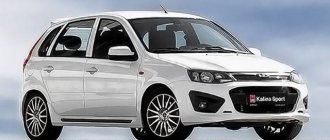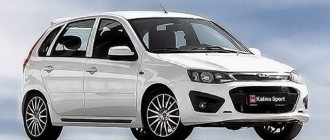While official representatives of Lada Vesta are just planning to start production of a new engine to launch the turbo vesta car on the market, Russian car studios and workshops are successfully implementing projects for the Vesta car at a good level for installing a Lada Vesta turbo kit kit. A good kit adds power to the car and improves other characteristics. True, the weaknesses of the machine also make themselves felt. Read the article and find out all the intricacies of turbo vesta and the turbo kit.
Lada Vesta turbocharged from the manufacturer
In general, the Lada concern has long presented to the world its version of a sports car with a Turbo Vesta turbocharger with a powerful engine, the power of which is 350 hp. It was made specifically for participation in circuit racing, and therefore it came with extended wheel frames for wheels with low-profile tires. How successful the project was can only be judged by racing drivers. All other car enthusiasts have to wait until the turbine finally goes on sale from the factory and becomes available to everyone. It is now known for sure that the turbocharged engine for Vesta will be assembled by the French company Renault and it will increase the car’s power to 150 hp, which is not bad compared to the current maximum of 122 hp. True, when this will happen is still unknown, so impatient motorists have to decide for themselves the issue of increasing engine power. If you have the preparation, you can even do this yourself.
“Sport” for a million: Vesta Sport against Toyota GT86 and turbo Rapid
With the appearance of Vesta Sport on sale this year, the price of VAZ cars exceeded a million rubles for the first time. Is the 145-horsepower Lada worth the money? Maybe it’s better to spend this amount on the Skoda Rapid 1.4 TSI, which, although 20 hp weaker, is faster than Vesta? Or go all out and look for a used, but real rear-wheel drive Toyota GT86 coupe with 200 horsepower?
For those who remember Granta for 230,000 rubles in 2011, the idea of giving a million rubles for Vesta, of course, seems wild. As well as for those who prefer something fairly used, but foreign. Nevertheless, we must admit that in the market as a whole, this is quite an adequate price for a 145-horsepower car with an impressive list of near-sport modifications.
The price of Lada Vesta Sport is from 1,009,900 rubles (this amount includes very decent equipment). For an additional fee - only a more advanced multimedia system with a color screen and navigation (plus 36,000 rubles). A Skoda Rapid with a 1.4 TSI engine and a DSG robot can be bought much cheaper - from 892,000 rubles, but this is a much more modest package than that of Vesta. We took the well-equipped Style version, which was also packed with options, with a total cost of 1,221,800 rubles. A 2013–2014 Toyota GT86 with a mileage of 40,000–100,000 km now costs the same as a new one – 1,200,000–1,400,000 rubles
Vesta Sport does not claim to be closely related to the real racing Vestas that compete in the Russian circuit racing series, but there is a lot of noteworthy things about the base sedan. Let’s leave aside the spectacular body kit and “decorations” in the cabin for now, let’s first go through the technology. After installing different camshafts, a modified intake system and new firmware, as much as 145 hp was removed from the long-suffering 1.8-liter VAZ engine in the Sport version. and 184 Nm, which is 23 “horses” and 14 “newtons” more than a conventional engine. The side-mounted exhaust with larger-diameter pipes mumbles pleasantly in the city and during shifts, but on a long journey it becomes very tiring. The engine transmits a little more vibration to the body - the Sport has four engine mounts instead of three. Transmission is a 5-speed manual only.
At acceleration, the Sport is faster than the regular 122-horsepower Vesta, although only by 0.6 seconds (9.6 seconds to 100 km/h). Well, after 140–150 km/h, the “sports” Vesta accelerates completely sluggishly and reaches the “maximum speed” of 193 km/h with great difficulty.
Such dynamics and traction control would not interfere with an ordinary Vesta! But “Sport” also feels much more confident in corners and reacts more clearly to the steering wheel. The suspension here is stiffer, although it retains its energy intensity
On a high-speed straight line, the sedan is stable, reacts clearly, but without unnecessary sharpness, to the slightest deviation of the steering wheel. The Sport is equipped with new springs and shock absorbers, the car's track is widened by 15 mm at the rear and 35 mm at the front, the ground clearance is reduced to 147 mm, so Vesta corners better than any other AvtoVAZ production car! The steering knuckles have been additionally strengthened, and the CV joints now have a large number of splines. With the new suspension kinematics, Vesta rides harder and the ride is worse, but the information content of the steering has improved significantly, roll has decreased, and energy consumption has not suffered at all.
Our test took place at above-zero temperatures on dry asphalt, with all cars still wearing non-studded winter tires, and this had its effect. Vesta Sport showed a tendency to understeer (but only slightly). Last year we already had the opportunity to drive the summer Continental SportContact, which is “native” to Vesta “Sport”. With them, Vesta behaves more recklessly: when you release the gas in a turn, the balance is slightly different, and the car drives to the limit with a slight skid.
The Vesta Sport also turned out to have very good brakes - precise and reliable, withstanding even a series of full-throttle braking from speeds of 130–140 km/h. The diameter of the front discs here is as much as 300 mm, and the calipers have increased accordingly. By the way, have you noticed that the wheels are secured not with four, as usual on VAZs, but with five bolts? Don't be surprised, these are hubs from Renault Megane!
So, Vesta’s improvements are all on point. It’s just a pity that they don’t offer a self-locking device for the sports version. There is a field of activity for tuning masters.
The Rapid is the most comfortable and quiet car in our trio, with the best ride quality, which is even better when partially loaded. Rapid - very economical, you can easily meet 6.5–7 liters per “hundred”
The Rapid is just as faster than the Vesta Sport in acceleration to “hundreds” as the latter is faster than the “regular” Vesta 1.8 - that is, by 0.6 seconds. The Skoda suspension is an option for those who don’t need excessive rigidity: this is the most comfortable car in our trio. The steering wheel is quite light, but informative, and the intensity of deceleration, as on all Volkswagens, is measured by the stroke of the light pedal. When cornering, Skoda does everything clearly, reliably and clearly, but not recklessly.
Should the 7-speed DSG robot be considered an advantage or a disadvantage? Many doubt its reliability. However, the editorial Rapid with such a transmission drove more than 100,000 km and did not experience any problems. Well, the rate of fire of the DSG, especially in sports mode, has always been almost exemplary. For this reason alone, rapid acceleration on the Rapid happens by itself, but with rivals with manual gearboxes - it depends.
And in general, the combination of a 1.4-liter turbo engine with this gearbox is successful; the Rapid “pumps” very well for a family runabout. The only thing I didn’t like was the excessive damping of the gas pedal at low speeds - at the start you get either a dip or a strong jerk. But after 2000 rpm, the Skoda has excellent torque, and even after 130–140 km/h the car is much more lively than the more powerful Vesta Sport.
The Toyota GT86 is the only car in our test that breaks the eight-second sprint to 60 mph in 7.6 seconds. The coupe's handling is the sharpest and most precise, the suspension is the shortest and stiffest, and rear-wheel drive adds spice.
Compared to the rivals we have chosen, the Toyota GT86 is a car from another world. This is a full-fledged, albeit used, sports coupe without any discounts. A real car for fun. True, you expect more from the engine. It's impressive compared to small cars like Vesta and Rapid, but by the standards of real modern sports cars, its capabilities can't be called anything special. For comparison: this year the Koreans are bringing to our market the Hyundai i30N golf-class hatchback with engines of 249–275 hp. And Toyota only has 200 horsepower...
The dynamics of the GT86 are not capable of impressing anyone who has ever sat behind the wheel of a truly powerful car. This outrageous coupe with a result of 7.6 seconds is 1.4 seconds faster than the Rapid and two seconds faster than the Vesta Sport, but if we compare, for example, with the Skoda Octavia 1.8 TSI, then Toyota loses 0.2 seconds! And this despite the fact that this Octavia develops 180 hp. and does not pretend to be a sports car (a truly sports 220-horsepower Octavia RS is not supplied to us now).
The GT86 has another joke: this coupe belongs to a type of car that is now dying out, where the driver is maximally involved in the driving process and their unity reaches the highest level. It’s hard, shaking, noisy, cramped, but... how much fun it is to squeeze in your hands this precise, scalpel-like steering wheel that reacts to your slightest movement, click the short lever of the 6-speed manual transmission and listen to the metallic clang of the boxer, spun to the “redline” ! Turn off ESP, step on the gas and effectively drag the GT86 sideways through a series of familiar turns - with shifts and at drift-like high sliding angles. Only 200 power, but so much fun! There are not many cars in the world of similar power, but equally bright and giving so many emotions.
Coupe cars usually age later than others. So the Toyota GT has not lost its charisma even seven years after the start of production. Low landing, good silhouette, “pumped up” arches, gloomy “look”...
Would anyone who likes all this sharpness and uncompromisingness begin to think about the virtual absence of a back row, a worthless “noise” or a trunk that only fits a couple of diplomats? For what? Or will he worry about the fact that there is no way to buy a new GT86 in Russia, since Toyota sold its last coupes here in 2016: a very specific car was chosen by only about 400 Russian buyers over four years of sales. Apparently, not all of them were able to appreciate the merits of this model, so there is a relatively large selection on the secondary market: there are currently about 30 advertisements for the sale of the GT86 on Drome. You can find a decent copy.
For example, “our” Toyota GT86, which lived in Moscow for six years, looks very cheerful. Slightly faded paint, small chips, scratches on the rims and an interior that requires cleaning, where the side of the driver's seat is frayed - these are all conspicuous defects. According to the owner, for 55,000 km he did not experience any problems with the car, he only did maintenance. And what will happen to him? The design is the simplest: 6-speed manual, MacPherson strut in front and a Subarov 2.0-liter 200-horsepower boxer engine under the hood.
The interior of the GT86 does not look very modern, but it is quite decent. The ideal “steering wheel”, reclining low seating position, red stitching, aluminum pedals, stylish “climate” keys and a wide, full-width carbon fiber “board”
On the other hand, buying a Toyota GT86 is a sacrifice. And the main thing that you will have to give up is the ability to normally accommodate more than two people in the cabin. And the interior itself is a greeting from a rather distant past by automotive standards. Just look at this archaic monitor on the front panel. The stylish interiors of the new Camry, RAV4 or Prius are like the moon for him. Don't forget that the GT86 was created as a budget coupe, so the finishing materials here are simple. Well, the landing is very specific - very low. The seats hold your body in turns well, but it’s better not to sit in them while wearing outerwear—it’s a bit cramped.
Vesta Sport looks cool! All sporting attributes fit the theme - extended front fenders, new aggressive bumpers, 17-inch wheels, a “skirt” along the sills, a pair of flattened exhaust pipes, and organic design accents in bright red. By the way, Sport is the only Vesta that is produced in Togliatti, the rest of the modifications are in Izhevsk
AvtoVAZ has recently been very pleased with its ability to transform the appearance of its cars with the help of minor touches. No one will deny that the Cross modifications of the Vesta sedan and station wagon, as well as the XRAY hatchback, look much better than the base cars. So the “sport” version was a success. Send a Vesta like this to the race track now!
Vesta's interior design is quite successful, and the touches of the Sport version (inserts on the seats, trim on the dashboard and red stitching, as well as carbon-look inserts) significantly enliven it. But the quality of finishing materials is worse than that of Toyota and Skoda
The interior matches too. The front seats, made by the Korean company Daewon, are new, trimmed with Alcantara and vinyl inserts. The thinner cushion ensures a low seating position, and the lateral support is more pronounced. The interior was significantly enlivened with contrasting stitching and “carbon” inserts, and the steering wheel and manual lever were covered with leatherette that was pleasant to the touch. It has become much more fun than in regular Vestas, however, the quality of finishing materials has remained at the same level.
Skoda, after restyling two years ago, looks more expensive due to LED headlights, but still seems a bit boring. Rapid is also noticeably smaller in width than the other two test participants
In comparison with the Vesta, adorned with a spectacular body kit, the Skoda Rapid liftback is a gray mouse, and with not the best proportions. The car is narrow (1706 mm), but high (1461 mm and ground clearance 170 mm). The window sill line is lowered relative to the trunk and hood, the rear part is completely nondescript. Wheels with a diameter of 16 inches are lost in the large arches. Its advantage lies elsewhere: traditionally, like all Skodas, the Rapid pleases with a spacious interior and a very spacious trunk, which can be loaded even under the roof.
The interior of the Rapid in top trim levels looks very decent, and the quality of materials in the “Czech” is the best in the test. Visually, the interior seems more expensive due to the stylish metal insert across the entire width of the front panel, leather multifunction steering wheel, interesting trim pattern for the front seats and the most sophisticated multimedia screen
Both front seats of the Rapid are adjustable in height, and between them there is a small but comfortable box-armrest. The climate control is single-zone, and the windshield is heated, just like the Lada. The classic “tidy” with two “wells” is radially digitized, and in the middle there is an informative display
The finishing materials of the “Czech” are better than those of the other two. Rapid is a kind of little Octavia, where even hard plastic is made to look soft. Skoda has always been good in terms of ergonomics, and this “baby” is no exception. The seats are comfortable even with a minimum of adjustments, all the buttons are always at hand, and using the colorful multimedia screen is a pleasure. Skoda is also unrivaled in terms of noise insulation, although the wheel arches should have been insulated more thoroughly.
We really liked Vesta Sport: the sports department of AvtoVAZ created a very interesting car, and not as a small-scale modification, as was the case before. Perhaps the most interesting in terms of controllability in the entire history of the plant. Vesta began to ride faster, a little harder, but much more correct and thoroughbred. At the same time, the engineers managed to make sure that bad roads are not a problem for this “Sport”. Even in its most powerful modification, it is still a fairly roomy car with an impressive trunk size. Sport is worth the money, because the number of alterations is significant. But we’re not sure how many enthusiasts are willing to pay a million for a model from Tolyatti. Perhaps it’s worth offering buyers the regular Vesta, but boosted to 145 hp. engine: the standard suspension can handle such power, but the price could be reduced significantly. Vesta Sport is an absolutely niche product.
Only Vesta Sport and GT86 have hints of “sport”. These include double exhaust pipes, pseudo-diffusers, and laconic spoilers... The Skoda Rapid from the rear is an absolutely “civilian” car, which, incidentally, it really is
Skoda Rapid has never claimed the status of a “hot” hatchback (liftback). This is a solid family car with a huge trunk, a spacious interior, but a rather nondescript appearance. The trick is that Rapid can be bought in medium trim levels cheaper than Vesta Sport! At the same time, you will get a car with a higher-quality interior, with a “robot” with two clutches, and such a car will be faster than a “Sport” from Togliatti with a “mechanics”, and almost twice as economical.
Toyota GT86 is the car of a real egoist, for whom “fun to drive” is the most important criterion when choosing an “iron horse”. If you have gasoline in your blood and have the opportunity to buy a “jitishka” as a weekend car, then this would be an excellent option. And certainly the best of all this trinity, because only the Toyota coupe can be called a truly sports car, although not too fast in a straight line. But if you have children and suddenly consider the GT86 as the only car for the family, throw this idea out of your head: in a week, when the first euphoria subsides, your family will hate you, and your wife will most likely kick you out of the house with the words “where are you?” took this hard and tight suck"? That's when you'll be able to really get high, enjoying the filigree handling of the GT86 and pushing it sideways in every turn...
Technical characteristics of the tested vehicles (manufacturers' data)
| Lada Vesta Sport | Skoda Rapid | Toyota GT86 | |
| Body | |||
| Type | Sedan | Liftback | Coupe |
| Number of seats/doors | 5/4 | 5/5 | 2+2/2 |
| Engine | |||
| Type | Gasoline, with distributed injection | Petrol, direct injection and turbocharged | Gasoline, with distributed injection |
| Engine location | Front transverse | Front transverse | Front longitudinal |
| Number and arrangement of cylinders | 4, in a row | 4, in a row | 4, opposite |
| Working volume, cubic meters cm | 1774 | 1395 | 1998 |
| Power, hp at rpm | 145/6000 | 125/5000-6000 | 200/7000 |
| Torque, Nm at rpm | 184/3600 | 200/1400–4000 | 205/6400–6600 |
| Transmission | |||
| Drive unit | Front | Front | Rear |
| Transmission | 5-speed manual | 7-RCP (DSG) | 6-speed manual |
| Brakes | |||
| Front | Ventilated disc | Ventilated disc | Ventilated disc |
| Rear | Disk | Disk | Disk |
| Suspension | |||
| Front | Independent, spring, McPherson | Independent, spring, McPherson | Independent, spring, McPherson |
| Rear | Semi-dependent, spring | Semi-dependent, spring | Independent, spring, multi-link |
| Dimensions, volume, weight | |||
| Length/width/height, mm | 4420x1774x1478 | 4483x1706x1461 | 4240x1775x1285 |
| Wheelbase, mm | 2635 | 2602 | 2570 |
| Ground clearance, mm | 147 | 170 | 120 |
| Curb weight, kg | 1322 | 1227 | 1263 |
| Fuel tank volume, l | 55 | 55 | 50 |
| Trunk volume, min./max., l | 480 | 550/1490 | 243 |
| Tires | 205/50 R17 | 215/45 R16 | 215/45 R17 |
| Dynamic characteristics | |||
| Maximum speed, km/h | 193 | 208 | 210 |
| Acceleration to 100 km/h, sec. | 9,6 | 9,0 | 8,2 |
| Fuel consumption, l/100 km | |||
| Combined cycle | 7,9 | 5,3 | 7,8 |
| CO2 emissions, g/km, eq. Class | N.D./Euro-5 | 166/Euro-5 | 181/Euro-4 |
| Cost of the car, rub. | |||
| Basic equipment | 1 009 900 | 892 000 | – |
| Test car | 1 057 900 | 1 221 800 | 1 130 000–1 600 000* |
*- price of similar used Toyota GT86 with similar mileage on Drom.ru
Photobonus
What is a turbo kit
Before you decide to convert your beloved Lada into a modified Vesta Turbo, find out the intricacies of the turbo kit system and the consequences of installing it on the car. Firstly, such tuning will not cost only the installation of a turbine. A turbo kit for Lada Vesta is a set of components consisting of a turbocharger, turbo manifold, intercooler, gaskets, and sensors. Correct installation of all parts of the kit on the car will increase engine power by at least 2 times.
The operation of a turbocharger is based on the kinetic energy of exhaust gases. The process increases air pressure and at the same time increases the efficiency and power of the engine. What characteristics the car will have depends on its original condition, but in normal urban conditions the engine will behave worse than before installing the turbo kit. You should not install a turbocharged engine if the car is not used for long trips, racing or drifting. You will simply lose a lot of money/time without getting a clear result.
What do cars have in common?
Psychologically, it’s hard to pay 1 million rubles for a new Lada. There are almost no used cars on sale yet, because the car only appeared in 2022. For its million rubles, Vesta Sport offers customers a rear view camera, navigation, cruise, rain and light sensors, heated windshield and climate control.
The new Skoda Rapid with the same set of options will cost about 150 thousand more. But it can be found used, then the average cost will be 734 thousand rubles.
Both cars belong to the B+ class, cost the same, and both raise doubts because you never know what to expect from a sports budget car.
Also read: Berry again? Review of Lada Kalina II
Problems arising from engine loads
Any engine upgrade on a car leads to an improvement in its basic characteristics and sometimes causes problems. This is due to sharply increased loads. Among the problems we highlight:
Increased load on the clutch disc. This can be solved by replacing the standard factory disc with a 6-blade damper disc. It will allow you to grab the gear more softly and change it faster. As a result, the load will be significantly reduced. Problems with the exhaust manifold, in particular - burnout of the standard gasket. This problem is also being solved. The kit itself for the Lada Vesta includes an exhaust gasket that can effectively seal the junction of the turbocharger and manifold. High compression problem when using factory connecting rods and pistons. It is best to replace them with turbo pistons, which can reduce the compression ratio by increasing the combustion chamber. Errors in setting up the motor control unit. A specialist will help you fix them. The brake stock needs improvement as it is not able to cope with the sharply increased engine power. In general, we note that all the parts required for modification when installing a turbo kit on the Lada Vesta are already included in the kit, which means additional costs will increase slightly.
Who is more liquid during resale?
Vesta Sport and turbocharged Rapid lose value in different ways. And if now we cannot estimate how the sports version of Vesta will behave in three or five years, we can already assume what will happen to the price of this car. Heartless statistics say that any Lada loses in value in a year as much as a Skoda does in three years.
Our expert believes that a good “Rapid” without critical accidents, with a clean history and a good reputation, will sell quickly and easily, while the Vesta Sport will become cheaper and rot while waiting for its buyer. Even a new one is not very readily bought up, let alone a used one, and even one with a lot of problems.
Here is a live example: a brand new LADA Vesta Sport of the current year with a mileage of 16 thousand km:
A check via avtocod.ru showed that Vesta had already been in an accident:
In addition, she is listed as a lease and mortgage and has unpaid fines.
Also read: My eyes are wide open: which LADA Largus to buy aftermarket
But this does not mean at all that the Rapids are white and fluffy. They also need to be checked before you buy. This Skoda Rapid is also proving problematic.
The car is listed as collateral:
The collateral obligations will expire in April 2020. Until this time, it is better to either wait or go with the seller to the bank after the purchase and pay off the existing debt.
Also read: Beauty or the Beast: review of Skoda Yeti I problems
What's included in the turbo kit?
The standard kit for the Lada Vesta car includes parts that are already connected to each other. This greatly simplifies the installation of the structure on the engine. The key part of turbocharging is the turbocharger. The Mitsubishi TD04L is used here, although some car enthusiasts prefer the TD05. It is made in China, but is of very high quality. Engine torque, when installing this turbocharger, increases to 300 Nm. The kit includes an overhead Subaru turbo manifold. It is produced from hot-rolled bends in an argon environment and is additionally processed, resulting in a reliable wear-resistant part.
In addition to the two main parts, the kit includes: turbocharger gaskets, bolts, oil supply hose, copper washers, antifreeze supply hose, oil drain kit, piping, exhaust pipe, front intercooler, air and pressure sensors, fuel injectors, turbo pistons, connecting rod set and piston rings , air filter and other spare parts. Additionally, you will have to purchase a sports receiver instead of the standard one. Suitable manufacturer model: Clubturbo.
The more comfortable it is to drive
In this matter, Vesta wins: the higher the speed, the fewer road irregularities it notices. The Lada's suspension is omnivorous, but stiff, as befits a sports car, in order to better maintain its trajectory. Vesta Sport must have at least something of a sport - not dynamics, but at least a stiff suspension!
The Rapida suspension is also not an airy marshmallow cloud. It handles potholes and holes just as hard, but at the same time the suspension “breaks through.”
The steering is better tuned in Vesta. The car clearly enters turns and exits them along a given trajectory. The Rapid rolls a little more, but these changes will only be noticeable on the track, and not at city intersections.
Also read: Review of used Lada Priora: is it worth buying
Features of kit installation
When installing a turbo kit on a Lada Vesta, difficulties may arise. For example, the manifold, exhaust pipe, and turbine pass very close to the rubber hoses, which is why they can heat up. The situation can be corrected if the entire collector is moved to the right. Problems may arise due to the location of the receiver. In some situations, it may begin to touch the radiator frame. Experts advise lengthening the intake valves, due to which the receiver will move further away.
Setting up the engine control unit causes quite a few problems when installing a turbo kit. If you plan to assemble a turbo engine yourself, contact someone who has already done it, or a professional, regarding tuning. Other difficulties may arise during the installation process, but they are all easily resolved, so the goal is achieved in the end.
Is it just a matter of seconds?
“Vesta” from “sport” has only a name. Judge for yourself: 1.8-liter engine and 145 hp. s., which accelerate to hundreds in 9.6 seconds, while consuming 10.6 liters. Without a doubt, these are more dynamic indicators than the “regular” Vesta Sedan. But still they are not so impressive to be called “sport”.
Rapid accelerates in 9 seconds. on a turbocharged 1.4-liter engine with 125 hp. s., working in tandem with the DSG robot. This is a little faster than its “sporty” opponent, but still six tenths of a second does not matter for a city car.
However, the Rapid benefits from its DSG robot, which is faster than a manual gearbox. It also outweighs in torque: 200 Nm at 1,700 rpm versus 184 Nm at 3,600 rpm for the Lada. The values are not so grandiose, but they are the ones that give the feeling of fast acceleration in the Rapid and slow acceleration in the Vesta Sport.
Also read: Skoda Rapid review: pros and cons of the model
Cost of the set
The price of a finished kit for Lada Vesta can reach 70 thousand rubles. Plus, you will have to pay about 25 thousand rubles to the technician if you decide to install the kit at a car service center. The total amount is impressive. So it’s better to think 7 times why you are installing a turbo engine and whether these expenses are really necessary.
If the desire to modernize your car has not diminished, but you want to save at least a little, try doing the installation yourself. This will not take as much time and effort as it might initially seem, but you will have to get a good set of tools.
Content
- What do cars have in common?
- Is it just a matter of seconds?
- The more comfortable it is to drive
- What's more pleasant to look at?
- Who is more liquid during resale?
- Which car to choose
There are no budget sports cars left on the Russian new car market. But we decided that the LADA Vesta Sport and the turbocharged Skoda Rapid can fight for this title. Cars with different engines, but similar characteristics: almost equal acceleration, the same cost and a common target audience.
Let's figure out which of the two cars to choose and what to expect from them. In order not to be unfounded, we consulted with car selection specialist Sergei Ryzhkov.











